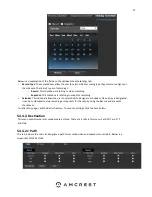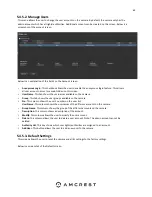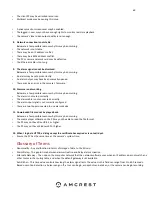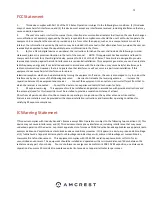
70
•
DDNS
–
Stands for Dynamic Domain Name System. DDNS is a
method of automatically updating
Name System (DNS), often in real time, with the active DNS configuration of its configured hostnames, addresses or other
information.
•
Default Gateway
–
The node on the computer network that the network software uses when an IP address does not match any
other routes in the routing table.
•
DHCP
–
Dynamic Host Configuration Protocol is a network protocol that enables a server to automatically assign an IP address to
a computer from a defined range of numbers (i.e., a scope) configured for a given network.
•
Fluency
–
Fluency described the lack of stuttering or excessive delay in a video stream. Fluency usually comes at the expense of
video quality when a network is constrained.
•
IP Address
–
Internet Protocol Address is a unique numerical label assigned to each device connected to a computer network.
The IP address allows communication between different devices on a network.
•
Main Stream
–
Main Stream is the main streaming protocol for the camera. Main stream uses more bandwidth and attempts to
keep quality and fluency high.
•
NO/NC
–
Normally Open and Normally Closed are options for sensor type. These settings allow for different exposure types when
capturing video and still images.
•
NTP
–
Network Time Protocol is a networking protocol for clock synchronization between computer systems over packet-
switched, variable-latency data networks.
•
P2P
–
Peer-to-Peer is a decentralized communications model in which each party has the same capabilities and either party can
initiate a communication session.
•
PPPoE
–
Point to Point Protocol over Ethernet is a network protocol for encapsulating Point to Point Protocol data packets inside
Ethernet frames.
•
QR Code
–
Quick Response code is a type of digital barcode that enables devices to share complex data strings quickly.
•
Record Delay
–
Record Delay specifies in seconds how long the delay between alarm activation and recording should be.
•
Relay Out
–
Relay Out triggers a connected alarm (connected to the alarm port on the back of the camera) when an alarm on the
camera is triggered.
•
S/N
–
S/N stands for serial number. The S/N is unique to each camera and can be used to connect to different Amcrest apps and
services to provide different methods of access to the camera.
•
Sensitivity
–
Sensitivity is the amount of change required to increase the motion detected by a percentage. The lower the
sensitivity, the more movement is required to trigger an alarm.
•
SMTP
–
Simple Main Transfer Protocol is an Internet standard for electronic mail (e-mail) transmission.
•
Static IP
–
An IP address that does not change.
•
Sub Stream
–
Sub Stream is an alternative streaming protocol for the camera. Sub stream uses less bandwidth and attempts to
keep fluency high at the expense of quality.
•
Subnet Mask
–
a 32-bit number that masks an IP address, and divides the IP address into network address and host address.
•
TCP/IP
–
TCP/IP stands for Transmission Control Protocol/Internet Protocol and it is the language/protocol that allows
communication between internet connected devices, whether on a local network, or a on the Internet at large.
•
Threshold
–
Threshold is the level that the motion detection needs to reach to trigger an alarm.
•
UPnP
–
UPnP stands for Universal Plug and Play, and it is a protocol used to easily connect devices to the internet.
•
Video Tamper
–
Video Tamper refers to any major changes happening to the video feed such as it being blocked out, interfered
with, or disconnected.




































